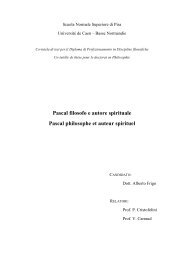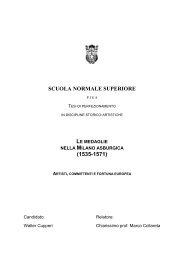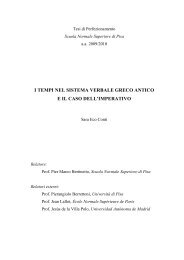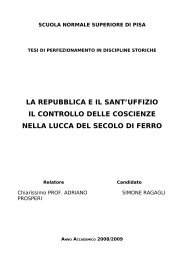CATULLUS 68 - Scuola Normale Superiore
CATULLUS 68 - Scuola Normale Superiore
CATULLUS 68 - Scuola Normale Superiore
You also want an ePaper? Increase the reach of your titles
YUMPU automatically turns print PDFs into web optimized ePapers that Google loves.
me’ is a much more suitable expression for what Allius did to Catullus than fouerit ‘he cherished me’. It is a<br />
striking coincidence that fouerit is also used by Agius in an apparent echo of this line. However, the<br />
coincidence may simply be due to the fact that Agius and Cornelissen both decided that iuuerit needed<br />
changing (Agius because the abbess Hathumod had not helped him in any way, Cornelissen because he<br />
decided that the word had to be corrupt) and they came across the same substitute.<br />
43f. There may be an echo of these lines at Sen. Her. F. 291-293 quidquid auida tot per annorum gradus /<br />
abscondit aetas redde et oblitos sui / lucisque pauidos ante te populos age (Seneca makes a different use of<br />
the association of memory with light).<br />
43 ne This is a conjecture of Calphurnius’; the transmitted reading is nec, after which tegat in the<br />
following line would have to be taken as a potential subjunctive. It is defended by Ellis ad loc., who<br />
translates ‘nor can time conceal …’, but this would disrupt the run of thought, unlike the energetic final<br />
subjunctive after ne. These lines constitute not a cautious assertion but a forceful and highly personal<br />
statement by Catullus about how he is going to re-pay Allius the favour of having helped him in his love-<br />
affair. Having defended nec in 1876 in his commentary and having printed it in his 1878 edition, Ellis<br />
himself was converted to ne and wrote it in his 1904 Oxford Classical Text.<br />
The corruption may well have triggered by nec at the start of line 49. Baehrens (1885 ad loc. and p. 51)<br />
argues in favour of the spelling nei, but this does not appear to be attested after CIL 1.582.19, the Tabula<br />
Bantina, which bears the text of a law written some time between 133 and 118 B.C.<br />
fugiens … aetas It is here that fugio is first applied to time in surviving Latin literature, an usage that is<br />
common in later poetry: compare Hor. Od. 1.11.7f. fugerit inuida / aetas and Sen. Phaedr. 446 aetate fruere:<br />
mobili cursu fugit; less closely Verg. Geo. 3.284 fugit interea, fugit irreparabile tempus and see further OLD<br />
s.v. fugio 8a and TLL 6.1.1484.11-27.<br />
aetas stands for time itself, as also at Enn. Ann. 406 Skutsch postremo longinqua dies (gen.) confecerit aetas<br />
and Cic. Marc. 11 ut tropaeis et monumentis tuis adlatura finem sit aetas; see further OLD s.v., 7a and TLL<br />
1.1137.73-1138.21. aetas is often contrasted with shorter units of time: thus Cic. N.D. 2.64 consumit aetas<br />
temporum spatia annisque praeteritis insaturabiliter expletur, Sen. Her. F. 291f. (quoted above on 43f.) and<br />
Lucr. 1.467f. ea saecla hominum … irreuocabilis abstulerit iam praeterita aetas (note the contrast with<br />
saecla).<br />
saeclis obliuiscentibus Probably an ablative absolute. Note Varro’s definition of the noun at L.L. 6.11<br />
saeclum spatium annorum centum uocarunt, dictum a sene, quod longissimum spatium senescendorum<br />
hominum id putarunt (his etymology is wrong: see Ernout-Meillet s.v.). saec(u)lum can refer to a generation,<br />
understood either as a group of people or as a period of a time, or to a race of men, or to a long period of<br />
time, in particular to a century (OLD s.v.). Elsewhere, except at 64.22 o nimis optato saeclorum tempore<br />
nati, Catullus always uses the word in connection with the relation of time to memory and literature, as here:<br />
thus 1.8-10 quicquid hoc libelli, / qualecumque, quod … plus uno maneat perenne saeclo, 14.23 saecli<br />
157






